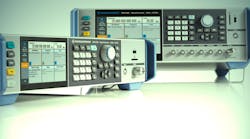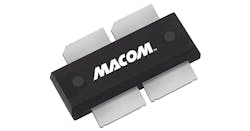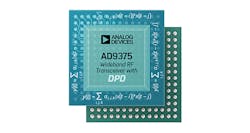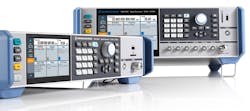RF/Microwave Industry Returns to Boston for EDICON
Download this article as a .PDF
Given a late-summer chance to gather in Boston, a healthy portion of the RF/microwave industry came together this September for the second-ever U.S. running of the Electronic Design Innovation Conference & Exhibition (EDICON), held in the Hynes Convention Center.
The conference and exhibition drew a broad cross section of the industry, from amplifier designers to software and test equipment suppliers, with the common themes of 5G and more millimeter-wave applications running through many of the technical presentations and at the exhibition booths. Visitors to the show were knowledgeable, and many appear to be preparing for the coming of 5G wireless networks—and what that will mean for them and their companies.
Held Sept. 11-13, the 2017 edition of EDICON attracted thousands of visitors and more than 100 industry company exhibitors, showing everything from tiny active devices to large test systems. The show floor provided a representative sampling of the industry, with opportunities for visitors to pick up free demonstration copies of design and test software and learn more about new developments at some of the leading companies.
MACOM greeted EDICON exhibition visitors from a small but highly visible booth near the entrance of the show floor. Although the booth held samples of the company’s many diode and optical communications components, perhaps the products of greatest interest were based on MACOM’s GaN-on-Si technology, such as high-power transistors and integrated amplifiers.
One of the company’s impressive discrete GaN transistors, the MAGe-102425-300, is based on fourth-generation GaN-on-Si technology. It operates on +50 V dc and delivers 300 W saturated output power with 16-dB gain at 2.45 GHz. The transistor, which is supplied in a rugged flange housing (Fig. 1), is intended for ISM-band applications at 2.4 to 2.5 GHz. It is a candidate for solid-state heating and cooking applications and even for use in automotive ignition systems.
Just across the aisle from MACOM, several large booths from Analog Devices and National Instruments dominated the show floor and captured the attention of visitors with active demonstrations of their products. For Analog Devices, it was the various versions of its RadioVerse radio integrated circuits (ICs) that brought interested parties to the booth, especially those working on wireless communications systems. This series of agile RF transceivers based on software-defined-radio (SDR) technology provides users with the flexibility to meet performance requirements by means of software tuning, while minimizing power consumption and taking advantage of the network benefits of massive multiple-input, multiple-output (MIMO) antenna techniques.
The EDICON crowd was energized by the introduction of the latest RadioVerse transceiver, the AD9375 (Fig. 2), at the show. Building on the proven design of the firm’s earlier AD9371 radio transceiver, the AD9375 covers a range of 300 to 6,000 MHz with dual differential transmitters and receivers. It includes an observation receiver with two input ports and a sniffer receiver with three input ports.
The highly integrated transceiver includes its own digital-predistortion (DPD) circuitry for a significant reduction in power consumption compared to DPD system approaches based on external field-programmable gate arrays (FPGAs). The simplicity and lower cost resulting from the DPD integration helps to speed wireless communications functionality to market in small cells and other smaller wireless application areas. The AD9375 supports 3G and 4G waveforms with instantaneous signal bandwidths as wide as 40 MHz.
Across the floor, National Instruments was showing how modular PXI Express test instruments fit together to create a complete RF/microwave measurement system—in this case, its PXI Vector Signal Transceiver (VST) system. Of the many different test-instrument formats on the EDICON show floor, the VST’s three-slot, 3U-high PXI Express format might have been one of the more familiar “plug-and-play” modular measurement systems for many visitors, with its capabilities to perform real-time vector signal measurements through 6 GHz and show results instantly by merit of a high-power SDR architecture. Measurements are greatly simplified through the use of the VST test software, based on the company’s popular LabVIEW test software.
Software Solutions
Not to be outdone, the folks on the software side of the house at NI AWR demonstrated the new features in the latest version of Version 13 of the NI AWR Design Environment (Version 13), including Microwave Office for designing and optimizing the performance of high-frequency circuits. Visitors to the NI AWR booth had a choice of computers with different software programs and could even perform system-level simulations using a copy of the NI AWR Visual System Simulator (VSS).
Visitors to the booth could also learn more about the LabVIEW Communications System Design Suite, which allows users to design and prototype communications systems based on National Instruments’ flexible software-defined-radio (SDR) system architecture. The single development platform includes a system designer, compiler, and design simulation tools to explore different architectures before committing to hardware.
Nuhertz Technologies offered visitors to its booth (and website) free 30-day trials of its FilterSolutions filter design software, including literature handouts on capabilities for designing RF/microwave filters with defected ground structures (DGS). In a microstrip circuit, a DGS is some form of intentional defect or etching in the ground plane that results in notch resonators, which can be used to reduce, for example, spurious levels or tune spurious frequencies in different kinds of high-frequency filters. The FilterSolutions software includes an export function that allows it to work with DGS models from the NI AWR Design Environment.
Mician GmbH demonstrated how to use its μWave Wizard full-wave three-dimensional (3D) EM simulation software to create high-frequency components, with the help of a large library of predefined shapes and elements. The user-friendly software is written in modular fashion, with blocks devoted to designing different types of filters, such as lowpass filters (LPFs), bandpass filters (BPFs), and antennas. Modules are also devoted to optimization, yield analysis, and even performance tuning, allowing users to perform analyses in the frequency and time domains.
COMSOL presented visitors with its versatile COMSOL Multiphysics software and how it can be used for such “unorthodox” modeling challenges as studying the nonlinear thermal effects of heat sources (such as power transistors and amplifiers) embedded in electronic circuits and systems. The software’s thermal models are based on computer tomography studies of different materials, and these models provide software users with the opportunity to simulate the impact of, for example, different packaging materials on the thermal management of a design at different power levels.
Testing the Limits
For engineers in need of an upgrade on the test bench, EDICON offered more than a few examples of the latest RF/microwave test instruments, including pocket-sized one-port VNAs from Copper Mountain Technologies. With units covering bandwidths as wide as 1 MHz to 18 GHz, such as the R180 (Fig. 3), these USB-powered reflectometers make it possible to bring the test equipment to the device under test (DUT), without cables—rather than the other way around—for highly accurate reflectometer (S11) measurements. As with other USB test instruments, data is stored and displayed on the host computer’s screen and popular test software programs, such as LabVIEW and MATLAB, can be used to automate measurements.
In addition to a fair share of exhibition booths with low-noise signal sources, a number of companies provided the means to measure the phase noise of those sources, including Holtzworth Instrumentation with its HA7062C real-time phase-noise analyzer. The company leveraged its expertise in frequency synthesizers to create the reconfigurable front-end design of this analyzer, with a base frequency range of 10 MHz to 6 GHz, which can be extended to 26.5 GHz by adding a frequency downconverter. With a measurement noise floor of −195 dBc/Hz, the instrument analyzes source phase noise at offsets from 0.1 Hz to 40 MHz.
Fast switching speed has long been a key characteristic of test signal sources from Berkeley Nucleonics Corp., and the company’s exhibition booth at EDICON 2017 didn’t disappoint, with a number of models providing microsecond switching speed. Given the growing number of applications employing phased-array antennas or phase-coherent communications signals such as in in-phase (I) and quadrature (Q) communications systems, the company’s 855 series of signal generators drew some interested visitors.
Available with upper-frequency limits of 6.2, 12.5, and 20.0 GHz and from two to eight independent channels, the 855 series signal generators can achieve frequency and power switching as fast as 10 us for effective use in automatic-test-equipment (ATE) systems. Output-power levels can be adjusted from −90 to +27 dBm and the phase noise is what one would expect from a high-performance test signal generator: −131 dBc/Hz offset 1 kHz from a 500-MHz carrier and −115 dBc/Hz offset 1 kHz from a 4-GHz carrier. The frequency stability is based on an internal oven-controlled crystal oscillator (OCXO), although external frequency references of 10, 100, or 1,000 MHz can also be used.
With an exhibition floor highly expectant of great things to come from 5G wireless communications networks, strong needs exist to support existing wireless communications systems. This includes 4G Long Term Evolution Advanced (LTE-A) equipment, and Anritsu drew a good number of visitors for its all-in-one communications systems tester, the model MT8821C.
With a standard frequency range of 30 MHz to 3.8 GHz and options to extend the range to 6.0 GHz, the analyzer supports all wireless communications systems currently in use, including CDMA 2000, GSM, W-CDMA, and LTE/LTE-A with multiple-input, multiple-output (MIMO) antenna configurations. In contrast to many smaller instruments on the show floor designed for USB connections to a computer, the MT8821C is virtually a system within an enclosure, with a dedicated computer, display screen, and radio front-end subsystem to emulate the performance of the systems that it analyzes.
For those who simply required more test signal power in their measurement systems, RF-Lambda showed it line of AC-powered microwave amplifiers, including its model RAMP01G22GA with 8 W output power from 1 to 22 GHz. Suitable for test systems and short-haul communications links, the amplifier provides 50-Ω impedance-matched input and output ports and delivers 42-dB gain with 5-dB noise figure across its wide frequency range. Lower-frequency amplifiers in the line offer higher power levels, while higher-frequency models extend past 100 GHz with less output power.
One of the better-kept secrets among the leading test-and-measurement companies at the 2017 EDICON was the almost-hidden HA-Z24E external preamplifier used in a spectrum analyzer demonstration at the Rohde & Schwarz booth. The bandwidth of the amplifier alone, at 1 to 85 GHz, is impressive, but the fact that it delivers about 23 dB small-signal gain from about 65 to 75 GHz—and is as simple to connect as plugging in a couple of 1-mm connectors and a USB connector to the spectrum analyzer—turns a spectrum analyzer with sufficient bandwidth into a millimeter-wave activity receiver.
The low-key approach of Rohde & Schwarz’s representatives also belied the outstanding performance of some of the other instruments on display, including the R&S SMA100B signal generators, with reference-quality phase-noise performance. Available in various frequency configurations through 20 GHz, the R&S SMA100B generators (Fig. 4) boast phase noise of −152 dBc/Hz offset 20 kHz from a 1-GHz carrier with high carrier power and low harmonic and spurious levels. For a show floor brimming with phase-noise measurement systems, this is the signal source that sets the bar on where the noise levels can be at microwave frequencies.
Those wishing to learn more about load-pull and source-pull tuners and testing actually had a choice of equipment and software suppliers at the 2017 EDICON, with representatives from both Focus Microwaves and Maury Microwave exhibiting their high-performance test systems.
Growing interest in millimeter-wave frequency bands for automotive and 5G wireless applications fuels the need for developing impedance matching networks for such components as power amplifiers, and a multipurpose impedance tuner such as the MPT 110200 from Focus Microwaves provides a usable frequency range of 20 to 110 GHz for the design and development of millimeter-wave components. Similarly, automated impedance tuners from Maury Microwave were on display at EDICON for measurements in bands from 33 to 110 GHz, encouraging new product developments in the millimeter-wave frequency ranges.
Material Improvements
A number of materials-based developments were unveiled on the EDICON exhibition floor, perhaps most noteworthy the emergence of Menlo Micro and its use of glass substrates to fabricate RF/microwave components. Growing its technology from research begun at General Electric’s Global Research Center, Menlo Micro has found a way to fabricate high-power microwave electromechanical switches on glass, using proprietary metal alloys and processing techniques. The company’s material-based Digital Micro-Switch (DMS) technology is based on glass substrates from Corning, Inc., a supplier that is also an investor in the new company.
In terms of performance, the electromechanical switches trim insertion loss to less than 0.3 dB through 12 GHz and are usable across bandwidths as wide as DC to 18 GHz. As an example, the MM3100 is a six-channel, single-pole, single-throw (SPST) digital microswitch with bandwidth of greater than DC to 3 GHz. The on-state insertion loss is less than 0.3 dB at 3 GHz with better than 25 dB isolation at 3 GHz. The switch, which is supplied in a hermetic LGA package measuring just 6 × 6 × 3 mm, can handle 25 W CW power and 200 W pulsed power with less than 10 μs switching speed. It is extremely reliable, rated for more than 3 billion switching operations.
To support a growing appetite for millimeter-wave applications on the show floor, materials supplier Rogers Corp. displayed samples of its ceramic-filled, PTFE-based, woven-glass-reinforced CLTE-MW laminates and 5-mil-thick RO3003 laminates with low loss at millimeter-wave frequencies. The materials have been used in 77-GHz automotive radar and provide a starting point for 60 GHz and other frequencies being considered as line-of-sight data links in 5G wireless networks.





